Automation for Hybrid and Multicloud from Cisco and Red Hat White Paper
Available Languages
Bias-Free Language
The documentation set for this product strives to use bias-free language. For the purposes of this documentation set, bias-free is defined as language that does not imply discrimination based on age, disability, gender, racial identity, ethnic identity, sexual orientation, socioeconomic status, and intersectionality. Exceptions may be present in the documentation due to language that is hardcoded in the user interfaces of the product software, language used based on RFP documentation, or language that is used by a referenced third-party product. Learn more about how Cisco is using Inclusive Language.
We are working in a multidimensional world of data and applications accessed by a workforce shifting among centralized campuses to work-from-home offices to work-from-anywhere. Data is widely distributed, and business-critical applications are becoming containerized microservices disseminated over on-premises, edge-cloud, and public cloud data center locations. These applications rely on agile and resilient networks to provide the best level of experience for the workforce and customers.
It is therefore a multidimensional challenge for IT to keep applications and networks in sync. With the ever-increasing scope of the roles played by NetOps and DevOps, an automation toolset is needed to accelerate data center operations and securely manage the expansion to hybrid and multicloud environments. Cisco Nexus® Dashboard (CND) provides a single focal point to unite the disparate views of globe-spanning multicloud data center operations and application deployment and performance.
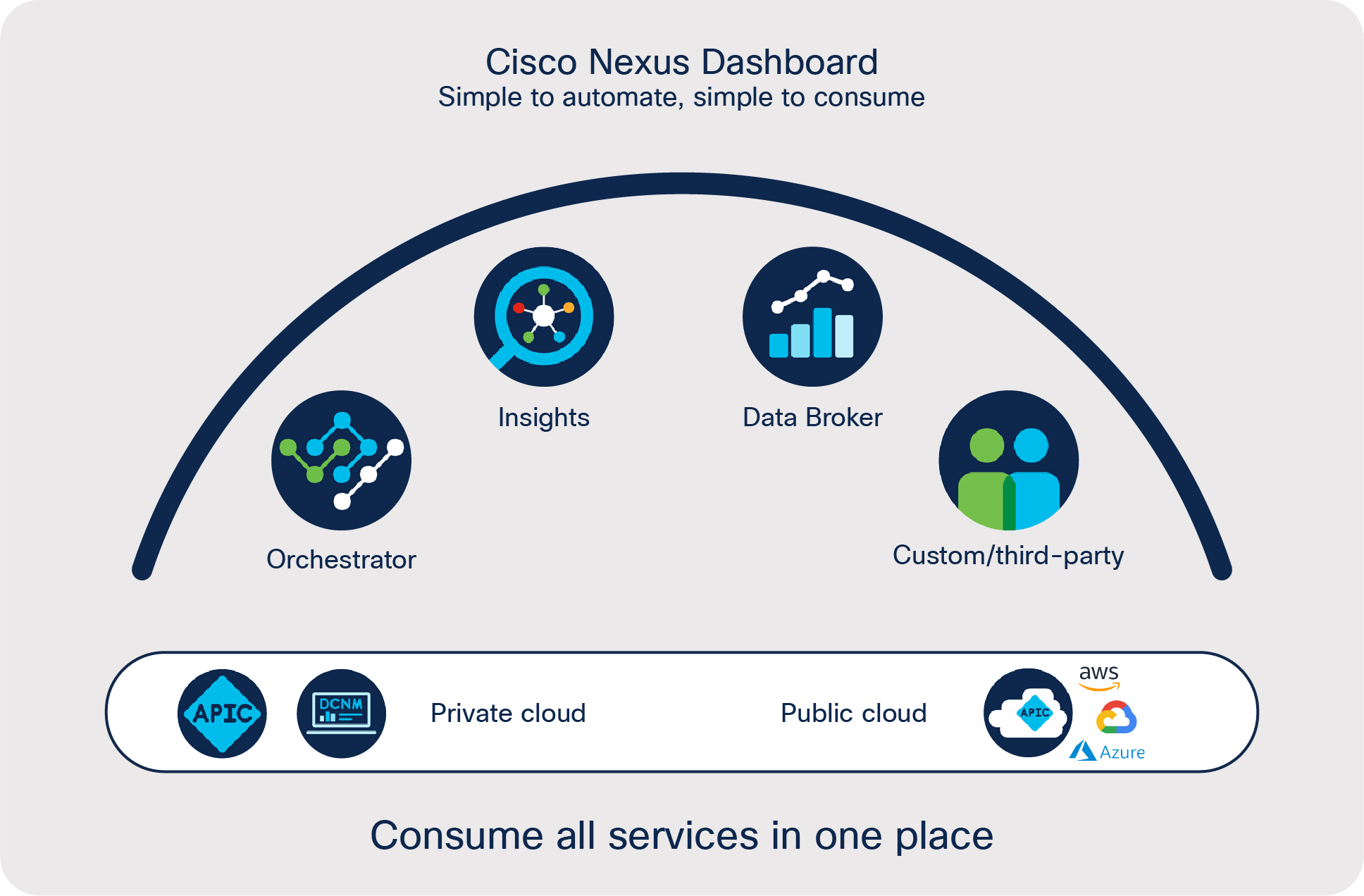
The Cisco Nexus Dashboard combines powerful services together in one platform
When working with a myriad of shifting cloud services, multisite connections, and third-party APIs, it can be arduous to continuously accelerate hybrid cloud and multi-data-center operations. Cisco Nexus Dashboard combines Orchestrator, Insights, and third-party services to give NetOps and DevOps teams an intuitive view of multiple data center fabrics. It provides the ability for NetOps to focus on critical anomalies, revealing root causes, and providing remediation suggestions that can be implemented with a click. It also provides DevOps with an automation toolset to manage and optimize applications.
Cisco Nexus Dashboard Orchestrator (previously Cisco ACI® Multi-Site Orchestrator) enables NetOps to set consistent connectivity and security policies across multiple data center sites and fabrics. Cisco Nexus Dashboard Orchestrator also enables end-to-end automation across data- center, SD-WAN, and enterprise branch and campus networks. Integration with Cisco SD-WAN optimizes path selection for traffic among data centers and branches to deliver on application service level objectives. Integration with Cisco DNA Center delivers consistent, identity-based security policies across the workforce and applications.
Cisco Nexus Dashboard Insights (previously Cisco Nexus Insights) incorporates a set of advanced alerting, baselining, correlation, and forecasting algorithms to provide deep understandings into the behavior of the network. It also analyzes flow telemetry data streamed from Cisco Nexus 9000 Series Switches across data-center networks to provide full-stack observability. The Insights service and AppDynamics® are tightly integrated to pinpoint exactly where and when an application issue originated from a network perspective. This results in proactive notifications, shorter time to troubleshoot, and better coordination between DevOps and NetOps.
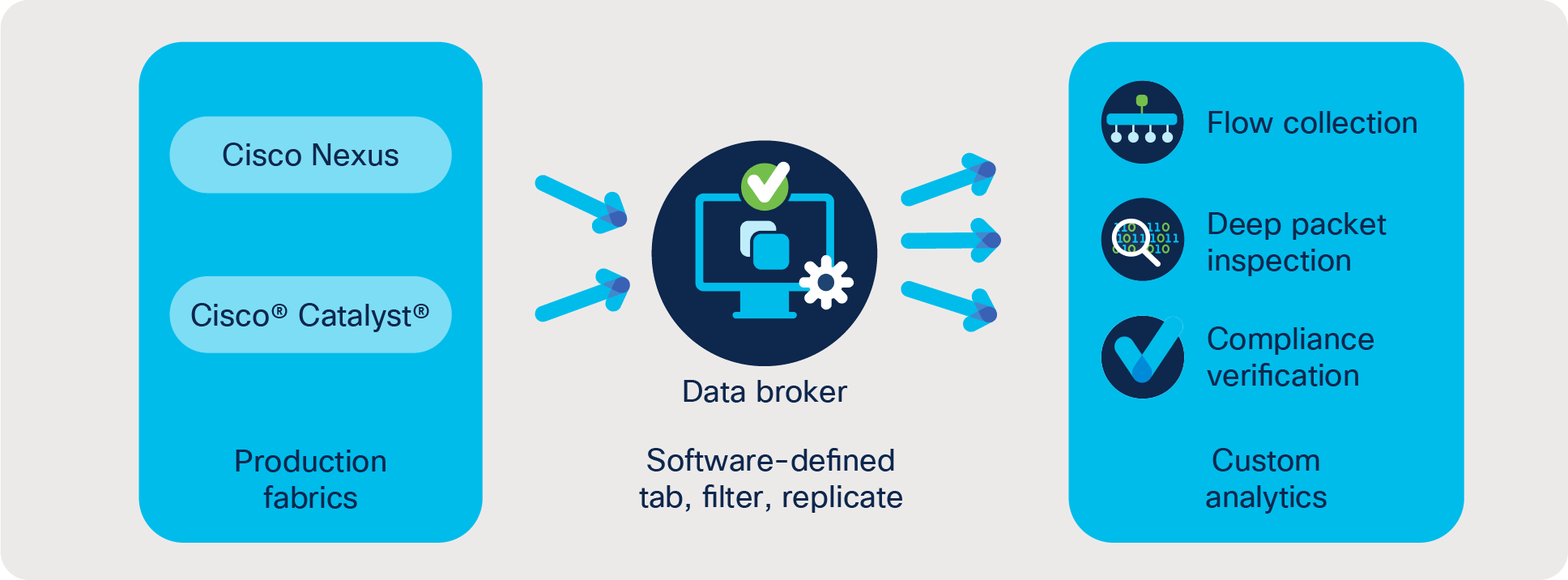
Cisco Nexus Dashboard Data Broker enables NetOps to programmatically manage aggregating, filtering, and forwarding complete flows to custom analytics tools
Third-party automation tools are critical to improving reporting workflows and responding to issues encountered by distributed workloads. Cisco Nexus Dashboard has built-in integrations with third-party services such as ServiceNow, one of the most prevalent IT service management platforms. With the ServiceNow integrations, NetOps and DevOps can open and track tickets from within Cisco Nexus Dashboard. From one portal, operation teams get visibility into the status of open tickets, resulting in the automation of troubleshooting for faster resolutions across fabrics.
With these integrated services united in Cisco Nexus Dashboard, NetOps can achieve command and control over global network fabrics, optimizing performance and attaining insights into data-center and cloud operations.
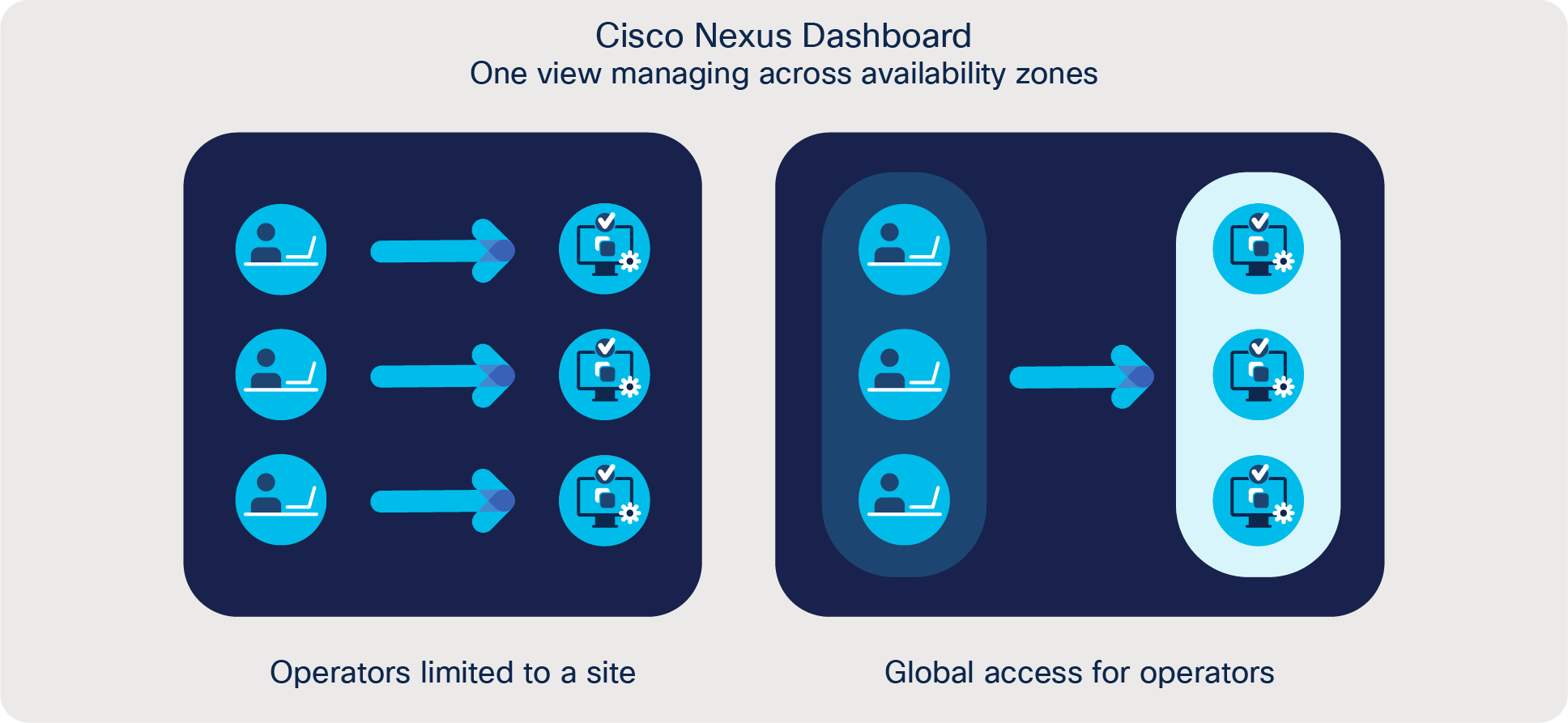
Cisco Nexus Dashboard integrated services give NetOps command and control over global network fabrics
The Cisco Cloud ACI solution extends the successful capabilities of Cisco ACI in private clouds into public cloud environments (AWS, Microsoft Azure, and now Google Cloud). This solution includes the Cisco Cloud Application Policy Infrastructure Controller (APIC), which runs natively in public clouds to provide automated connectivity, policy translation, and enhanced visibility of workloads in the public cloud. This solution brings a suite of capabilities to extend your on-premises data center into true multicloud architectures, helping to drive policy and operations consistency regardless of where your applications or data reside.
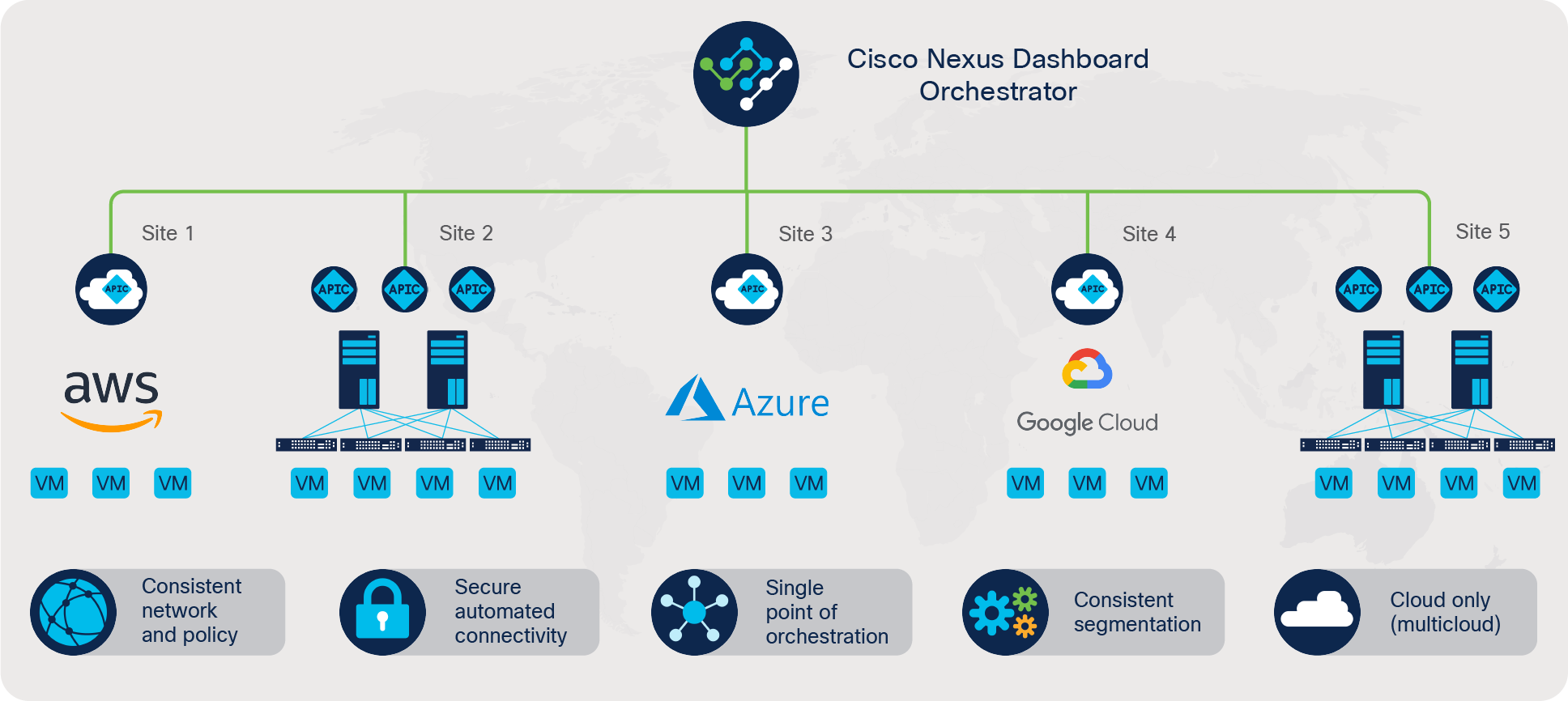
Cisco Nexus Dashboard Orchestrator offers multi-site networking orchestration and policy management from a single pane of glass
Solution from Cisco and Ansible enables DevOps to deliver a superior application experience
From the workforce point of view, a significant aspect of excellent application experience is the ability of DevOps to rapidly deliver new application releases and fix existing issues affecting workflows. NetOps, in turn, needs the network to keep pace with Continuous Integration/ Continuous Delivery (CI/CD) of hybrid and cloud applications.
The Cisco Red Hat partnership empowers the two teams to work together using an Infrastructure as Code (IaC) approach. DevOps can update applications in data centers and clouds without requesting NetOps deployment assistance, while NetOps knows that the processes DevOps is using are predefined, tested, and approved.
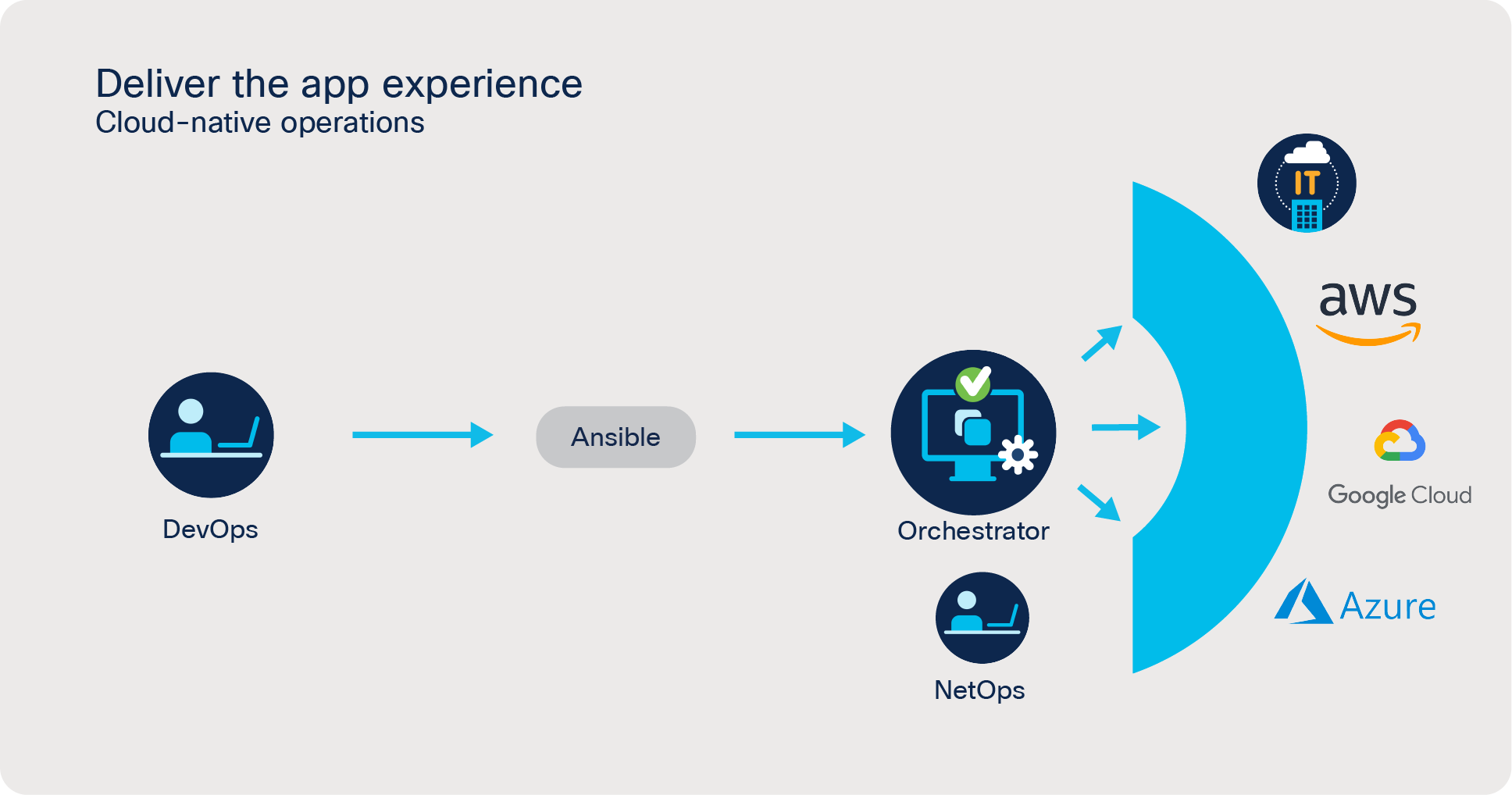
Ansible modules for NDO enable developers to describe in code the components and resources needed to run an application in a data center or cloud
Ansible brings numerous synergies to a Cisco Nexus Dashboard environment with its simple automation language; powerful features, such as application deployment, configuration management, and workflow orchestration; and an agentless architecture that makes the execution environment predictable and secure. More importantly, the Ansible–Cisco Nexus Dashboard solution enables network administrators to create and easily update network policies that can be applied consistently across the entire hybrid and multicloud environment. Furthermore, with CI/CD pipeline workflow, customers can quickly test changes to their multicloud networks before they push to production, in a DevOps-friendly way, with speed, consistency, and minimized risk.
Ansible Modules for Cisco Nexus Dashboard Orchestrator and Cisco Nexus Dashboard Insights
Cisco Nexus Dashboard Orchestrator (NDO) features a REST API that can be easily accessed and leveraged by Ansible. Administrators can download the Ansible NDO collection from Ansible Galaxy. They can then create a playbook, or set of automation instructions, as well as an inventory file, which lists the devices to be automated.
Ansible modules for NDO cover a broad set of use cases. For example, administrators can configure universal entities and policies (for instance, switch registration, naming, user configurations, and firmware updates) and apply them consistently across the entire hybrid/multicloud environment. There are also modules that allow for tenant creation, along with all tenant and child configurations, such as VRFs, APs, BDs, EPGs, etc.
Ansible modules also make it easier to access Cisco Nexus Dashboard (CND) tools, such as Cisco Nexus Dashboard Insights. As mentioned earlier, NI helps with troubleshooting, root-cause analysis, and remediation of network issues. It allows NetOps teams to drill down into problems and sort them by severity and other categories.
Cisco Nexus Dashboard Insights draws network policies, switch configurations, and the data-plane state from network fabric controllers. It creates a map of the entire fabric and builds a model spanning underlays, overlays, and virtualization layers. The model establishes the network state and allows tool users to check whether Ansible-initiated policies or policy updates created by NetOps will achieve their objectives and do what they are supposed to do. All of this can be seamlessly and painlessly managed via a single pane of glass through Cisco Nexus Dashboard.
Red Hat Ansible integrations with Cisco data-center networking solutions enable the full power of automation. With the Ansible collections for Cisco Nexus Dashboard and Cisco Nexus Dashboard Orchestrator, customers can move from traditional scripting to robust, reusable automation. They can feel assured, knowing they are able to meet, head-on, the challenges of a hybrid and multicloud world.
The set of solutions combining Ansible and Cisco Nexus Dashboard (NDO) empowers network administrators to manage and apply policies, simply and consistently, across their entire hybrid and multicloud environments. These solutions enable flexible deployment models and allow NetOps to automate the configuration of new devices and provision network resources more efficiently and as needed by business applications. Finally, they apply a software development approach to networking and, through CI/CD pipelines and version control, enable large and dispersed teams of network administrators to work with more speed and agility, all while eliminating risk.